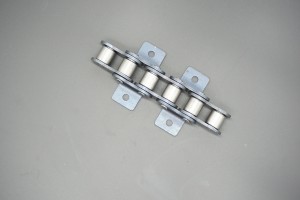In the field of mechanical systems and power transmission, roller chains play a vital role. These chains are used in a wide variety of applications including bicycles, industrial machinery and automotive engines. However, have you ever wondered whether roller chains push or pull the objects they are connected to? Today, we’ll delve into this interesting topic to better understand how roller chains behave in efficiently and reliably transmitting power.
The role of roller chain:
Roller chains are designed to transfer rotational motion and power from one component to another. They consist of a series of interconnected links, usually made of metal, with cylindrical rollers between the links. This construction allows the chain to efficiently mesh with gears, sprockets and other components for the transmission of motion and force.
The working principle of roller chain:
To understand whether roller chains push or pull, we need to understand how they work. When meshing with a gear or sprocket, a roller chain does not physically push or pull objects. Instead, they transmit power by pulling on each link in the chain, which ultimately pushes the driven component.
As the drive sprocket rotates, it pulls on the chain, causing each link to rotate with the rollers. This rotation continues throughout the chain until it reaches the driven sprocket. By engaging the driven sprocket, the chain transmits rotational force, effectively propelling the chain and any connected components.
The importance of tension:
An important aspect that affects the efficiency and durability of roller chains is tension. Proper tension in roller chains is critical to ensure efficient power transmission and prevent premature wear or failure.
Ideally, a roller chain should run under sufficient tension, neither too loose nor too tight. Insufficient tension can cause the chain to skip teeth on the sprockets or disengage completely, resulting in a complete loss of power transmission. Conversely, too much tension can lead to increased friction, increased wear, and even chain elongation.
Maintenance and lubrication:
To ensure the smooth operation of roller chains, regular maintenance and lubrication are essential. Lubrication not only reduces friction, but also protects the chain from corrosion, which can seriously affect its performance and service life.
Proper lubrication also enhances the tension characteristics of roller chains, ensuring consistent and reliable power transmission. Lubricants play a vital role in optimizing the efficiency of roller chain systems by reducing energy loss due to friction.
in conclusion:
In conclusion, roller chains neither push nor pull the objects they are connected to. Instead, they work by transferring power through a series of pulling and pushing motions. Understanding the behavior of roller chains is critical to engineers, mechanics and hobbyists as it allows for better design, maintenance and overall performance optimization.
Remember that maintaining proper tension and regular lubrication are key factors in ensuring the longevity and efficiency of your roller chain. So the next time you ride a bicycle or witness a large industrial machine in action, you can appreciate the intricacies of roller chains and how they enable reliable power transmission.
Post time: Jul-05-2023

